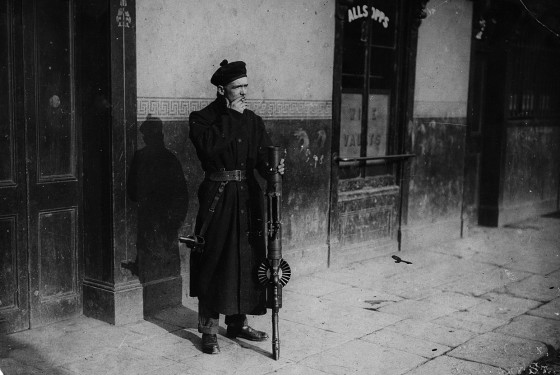
“Without them, the war could not have been won.”
By Philip Kay-Bujak
BEFORE the Second World War, the world’s naval powers hadn’t envisioned the type of mass landings that were going to be necessary in the coming conflict. Many countries had marine forces in their militaries, but even the largest, like the United States, Great Britain and Japan, tended to place their units aboard the larger capital warships. Only a few sustained the cost of smaller dedicated naval ships to the strategic concept of large-scale amphibious landings.
So, when the true scale of the widening conflict became evident, and British, American and Japanese war planners quickly realized that new fronts could and would be opened by way of offensives launched from the sea. When envisioning the types of craft needed for these sorts of operations, they initially turned to their own merchant fleets.
In the United States, attention was focused on the country’s large shipyards to provide large capacity vessels dedicated to transporting and landing tens of thousands of troops. The need was almost immediate. If amphibious operations were to be launched to retake territories conquered by Japan and Germany, rather than spending months designing and then manufacturing entirely new classes of ships, why not look for existing vessels and convert them into the LSI (L) — Landing Ship Infantry (Large) —that were needed? This leads us to one of the most underrated and yet pivotal classes of ships in the U.S. Merchant Fleet – the C1 cargo ships built for the U.S. Maritime Commission both before and during World War Two.

Some shipyards would go on to build dedicated troopships for crossing the Atlantic or Pacific, others would continue to build armed freighters and Liberty Ships of the C1 class, but these were not designed to get combat formations close to shore and be able to either disembark their men onto Landing Craft Assault boats or indeed carry their own complement of LCA’s.
One group of ships that this job went to was a variant of the C1 Cargo ship – the C1-S-AY1. With some of the hulls already under construction in 1941, the U.S. Maritime Commission was able to divert some ships designed for cargo use into serving as large scale infantry amphibious assault ship or LSI (L). These ships were remodelled by the Consolidated Steel Corporation out of their Wilmington, California dockyards in 1942 to 43.
Thirteen C1-S-AY1 ships, each originally launched with the word ‘Cape’ in the name (i.e. SS Cape Sable, SS Cape Lookout, SS Cape Douglas) were transferred to the British fleets where they were renamed the ‘Empire’ class. At 9,000 tons displacement, each took on a British Merchant Navy crew of 250 plus a Royal Navy detachment for their gunnery and to man the landing craft.
The SS Empire Javelin, for example, became home to the 551st Landing Craft Flotilla for the Normandy Landings and, able to carry 18 LCA’s and 1,400 men, she landed the 1st Battalion, 116th Infantry of the 29th Infantry Division on to Dog Green Beach on June 6, 1944.

But of course, there were numerous other LSI (L) variants that also served in different theatres of war. The British fleet created its own ‘First Four’ LSI (L)’s out of the conversion of suitable existing cargo or passenger ships. Suitable candidates for the British approach to amphibious landings needed to be faster than a freighter, with a low draft and able to have davits fitted in order to lower landing craft into the water from the sides of ships – the United States Marines however were more often lowered into their Higgins boats down the sides of ships by scramble nets.
The British ships of the ’Glen’ class – Glengyle, Glenearn, Glenroy and Breconshire were passenger liners destined for work in the Far East before they were converted to carry troops into amphibious landings. HMS Glengyle could carry 700 troops and 12 landing craft, and she was in the Bardia Raid of 1941, the evacuation of Greece, the Dieppe Raid in 1942 and the Allied invasions of Sicily and Salerno in 1943.
Even the Dutch Navy contributed to the fleet of LSI’s that the allies could use in their amphibious landings and the Dutch continental steamers the Queen Emma and Princess Beatrix, although these were both LSI (M) or medium ships at 4,000 tons, landed troops at Dieppe, Sicily, Normandy and southern France.

Although the United States was able to manufacture hundreds of LCI’s for different uses during the war, these should not become confused with the LSI (L). One of the ships of this class leased to the British on D-Day was LCI(L) 502 which landed British troops onto Gold Beach. Built specifically for this task in the United States in 1942, LCA 502 became one of hundreds of smaller 380-ton ships that still carried the LCI (L) identification and acted just as their much larger and older predecessors had done — the ‘Mother Ship’ throughout a landing – part transportation, part hospital, part casino, part church, part map room and part mortuary. Without them, the war could not have been won.
 Philip Kay-Bujak is the author of Empire Javelin: D Day Assault Ship. A retired headteacher and writer, his other books include The Bravest Man In the British Army (2018), The Life of Cicero (2023) and. He lives in East Sussex, U.K.
Philip Kay-Bujak is the author of Empire Javelin: D Day Assault Ship. A retired headteacher and writer, his other books include The Bravest Man In the British Army (2018), The Life of Cicero (2023) and. He lives in East Sussex, U.K.










https://pacificparatrooper.wordpress.com/wp-content/uploads/2021/11/vets-day.jpg